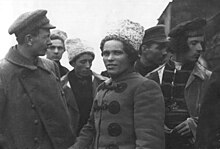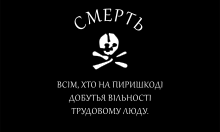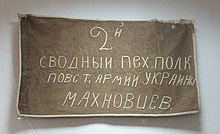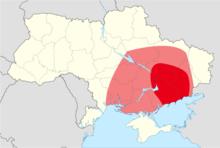Makhnovshchina
The Revolutionary Insurrectionary Army of Ukraine or Makhno ( Russian Махновщина . Scientific transliteration Machnovŝina , actually Revolutionary Insurgent Army of the Ukraine , Ukrainian Революційна Повстанська Армія України , and Black Army ) was an anarchist peasant - and partisan movement , which from 1917 to 1922 during the Russian Civil War in of Ukraine was active. With the aim of self-determination for the peasants and workers , it tried to implement anarchist social structures in large parts of the country.
Makhnovshchina is named after its initiator, the activist Nestor Makhno , who was influenced by the ideas of Mikhail Bakunin and Peter Kropotkins .
History of Makhnovshchina


After the peace treaty of Brest-Litovsk in 1918, Ukraine became formally independent as the Ukrainian People's Republic , but was de facto under the influence of the German Empire . It was the price that the Bolsheviks under Lenin and Trotsky initially had to pay for ending the First World War in Russia.
After his release from prison in Russia, Nestor Machno returned to Ukraine in 1917, where he began agitating among the peasants and workers to organize their union. He founded a rapidly growing partisan army of volunteer fighters who were free to choose their leader.
The Revolutionary Insurrectionary Army of Ukraine expelled the of the Central Powers used Hetman Pavlo Skoropadskyi , the bourgeois-liberal government made Symon Petliura meaningless, expropriated the large landowners and industrialists and organized the liberated areas, the "free Rayon" so-called by anarchist patterns in a network of self-governing communities , in which a council system was established.
In addition to supplying and distributing goods among the population, the municipalities and the various councils were also responsible for all other political areas such as transport, industry, warfare and culture. Among other things, this also included building schools, a literacy campaign and political education for farmers and partisans.
For the entire free Rajon , the decisions were voted in a rayon congress, a plenary assembly of council delegates, of which only three were carried out in the Ukraine during the time under Machnovshchina.
Many measures were delayed and hindered as a result of the military threat in the Russian civil war - first by the White Army of military units loyal to the Tsar and finally by the Red Army of the Bolsheviks.
At the time of its greatest expansion in December 1919, the Machnowschtschina belonged to 83,000 infantrymen and 20,135 cavalrymen in an area of about 100,000 km² with 7 million inhabitants. In Russian-German towns armed groups were formed to counter attacks by Machnovshchina.
During the first phase of the Russian civil war, Makhnovshchina was initially allied with the Red Army under Trotsky. In a grueling and often very cruel guerrilla war , the Machnovtsi, as the supporters of Machnovshchina were called, fought the White Armies advancing against central Russia under the generals Anton Ivanovich Denikin and Pyotr Nikolaevich Wrangel .
The Bolsheviks crush the movement
After the Bolsheviks, with the support of Makhovshchina, won the battle against the old powers - the German-Austrian occupiers and the White military - and stabilized their power in Russia, they turned against the Makhovshchina, just as they had previously crushed anarchist forces in Russia . Leon Trotsky led the fight against Makhnovshchina and ordered the destruction of the villages that were loyal to Nestor Makhno. However, when Pyotr Nikolaevich Wrangel , a general in the White Army, became too dangerous for the Bolsheviks, they again allied themselves with the anarchists. After Wrangel was driven out, the anarchist partisans of Makhnovshchina were ultimately defeated by the Red Army. By the summer of 1922 the last groups of Makhnovshchina had been defeated and wiped out. As the Ukrainian Soviet Republic, Ukraine became part of Soviet Russia or the Soviet Union . The Communist Party established itself as the dominant state party in Ukraine until the collapse of the Soviet Union at the end of 1991.
Machno himself and some of the fighters were able to leave for Romania on August 28, 1921, wounded. He spent the rest of his life in exile and died of tuberculosis on July 6, 1934 in a hospital for the poor in Paris.
Put k swobode (German: way to freedom) is considered the most important journal of the Machnowschtschina, published in Kharkiv .
literature
- Peter Arshinoff : History of the Machno movement (1918–1921). Unrast , Münster 1998, ISBN 3-928300-68-7 (reprint of the 1923 edition).
- Alexander Berkman : The Bolshevik Myth - Diary from the Russian Revolution 1920–1922 (Original title: The Bolchevik Myth , Boni and Liveright, New York, NY 1925, translated by Michael Halfbrodt), 2nd, expanded edition, Edition AV Verlag, Frankfurt am Main 2003, ISBN 978-3-936049-31-2 .
- Ettore Cinella: Machno in the Ukrainian Revolution from 1917 to 1921. In: Archives for the history of resistance and work. Volume 17/2003. Germinal Verlag, Fernwald (Annerod), ISBN 3-88663-417-5 , p. 311 ff.
- Dittmar Dahlmann : Land and Freedom. Machnovščina and Zapatismo as examples of agrarian revolutionary movements . Steiner, Stuttgart a. a. 1986, ISBN 3-515-04083-8 ( Studies on Modern History , Volume 35, also a dissertation at the University of Düsseldorf 1983).
- Roman Danyluk: Freedom and Justice - The history of Ukraine from a libertarian point of view . Edition AV, Lich 2010, ISBN 978-3-86841-029-7 .
- Arthur Müller-Lehning : Anarchism and Marxism in the Russian Revolution. Kramer , Berlin 1971, ISBN 3-87956-008-0 .
- Rudolf Rocker : The Bankruptcy of Russian State Communism. Publishing house Der Syndikalist , Fritz Kater , Berlin 1921; NA in: Rudolf Rocker, Emma Goldman : The Bolshevism. Nationalization of the Revolution. Underground Press, Berlin 1968, DNB 750221798 .
- Felix Schnell: rooms of horror. Violence and Group Militancy in Ukraine, 1905–1933 . Hamburger Edition: HIS-Verlag, Hamburg 2012, ISBN 978-3-86854-244-8 .
- Friedrich Schrader : A refugee trip through Ukraine. Journal pages from my escape from Constantinople. Mohr, Tübingen 1919 (eyewitness report by a social democratic German journalist who - on the flight from Constantinople to Berlin - experienced Ukraine in the civil war), DNB 576 414 182 .
- Horst Stowasser : The Machnotschina. An-Archia-Verlag, Wetzlar 1979, ISBN 3-922256-04-X .
- Volin : The Unknown Revolution. Volume 3. Verlag Association, Hamburg 1977, ISBN 3-88032-011-X .
Web links
- The Nestor Makhno Archive - International website with articles on Machno and Machnovschtschina with a German-speaking part
- Machno Solidarity - A joint project by German and Ukrainian anarcho-syndicalists in memory of Nestor Machno
- During the war by Jens Berger and Frank Benedikt on Telepolis
Individual evidence
- ↑ a b In times of war. In: Heise online . February 15, 2009, accessed July 20, 2013 .
- ↑ Belash, Victor / Belash, Aleksandr: Dorogi Nestora Machno. Istoricheskoe Povestvovanie . RVTS 1993, p. 333 ff.
- ^ End and new beginning of Russian-German Mennoniteism. (No longer available online.) Taufergeschichte.net, archived from the original on September 24, 2015 ; Retrieved December 6, 2014 . Info: The archive link was inserted automatically and has not yet been checked. Please check the original and archive link according to the instructions and then remove this notice.
- ↑ Schmidt Michael: A Makhnovist in Africa: Shalom Schwartzbard . In: A Zabalaza: Journal of Southern African Revolutionary Anarchism . No. 5 , May 2004, pp. 4 ( zabalaza.net ).


